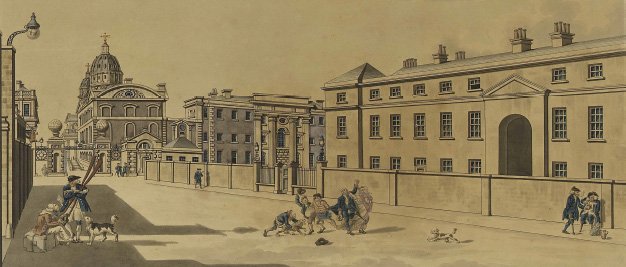The Dreadnought site has been in use for several centuries as a stabling area, a hospital, then a place of learning.
The Old Royal Naval College Site
The site of the Old Royal Naval College was originally that of the manor house of Bella Court, built in the 1420s by Humphrey, Duke of Gloucester and later acquired by Queen Margaret of Anjou and extended to create the Palace of Placentia. This was rebuilt by Henry VII as Greenwich Palace, with additions through the 16th century, but fell into disrepair during the Civil War.
Most buildings were demolished from the 1670s with only the foundations under Grand Square and some vaulted cellars under the Queen Anne building now remaining. The area of the Dreadnought Student Hub was that of the Palace stables and 'great barn' alongside Turnpin Lane, which then ran further east from the remaining section across the north end of Greenwich market.
In 1694, William III granted use of the Palace site for the Royal Hospital for Seamen - or 'Greenwich Hospital' as naval counterpart to the Royal Hospital for soldiers in Chelsea, according to the wishes of his late wife, Mary II; Hospital at this time meant 'alms-house' rather than medical facility. The overall master plan was by Sir Christopher Wren.
Royal Naval Hospital Infirmary
The proposed Dreadnought Student Hub building was originally constructed (1764-68) by Greenwich Hospital as its infirmary for treating sick Greenwich Pensioners. Previously patients had been accommodated within the main buildings but funds made available by the Admiralty at the end of the Seven Year’s War enabled the construction of separate accommodation. A further 'Helpless Ward' (part of which is now incorporated in the Stephen Lawrence Building) was added in 1808 but in 1811 a fire destroyed much of the north and west sides and the main building. Redevelopment and later adaptation (1835-45) included the complex being stuccoed as it appears externally today.
Funeral Gates
From 1849 to 1857 the site of Devonport House was the second burial ground from the Royal Naval Hospital, with burials on Tuesdays and Fridays at 10.00 a.m. Eventually some 20,000 men were buried there. Funeral processions would cross Romney Road from the Dreadnought building via the two sets of surviving funeral gates, Greenwich Pensioners being buried in mass graves that took about three weeks to top out. (Both sites were then walled round: the railings only date from the 1860s) In the 1870s and 1920s, remains were moved to the Hospital's later cemetery (now East Greenwich Pleasance) for digging of the Greenwich railway tunnel and the foundations of Devonport House.
Dreadnought Seamen's Hospital
Greenwich Hospital finally closed in 1869 and the infirmary was taken over from 1870 by the (merchant) Seamen's Hospital Society. It was renamed the Dreadnought Seamen's Hospital and replaced the last of three hospital ships on the Thames occupied by the Society from 1821 (the last two being named Dreadnought). The building was the administrative headquarters of the Society, treated patients and also carried out research into tropical diseases.
From 1872 the main Hospital buildings became the Royal Naval College, for the advanced training of Naval officers - with the Joint Services Defence College joining in 1983. Both left Greenwich in 1998. The Seamen's Hospital was funded by donations and the plaques in the Dreadnought building commemorate the societies and individuals who contributed towards its' running costs. One of these - the Silver Thimble Ward - commemorates the merchant seamen of World War I.
Ward Layout
The hospital held up to 256 patients in 64 four-man wards, each heated by a fireplace and lit by a sash window. Between 1907 and 1914 partitions were removed to create larger wards of six men.
Accommodation
From 1877 until the Devonport Nurses' Home opened (1924-35), female nurses were accommodated in the attic storey of the Hospital, which was also a nurses' training school.
World War II & the NHS
The Hospital was closed after bomb damage in World War II - in 1940 a direct hit destroyed operating theatres and the chapel and in 1941 an incendiary attach destroyed most of the roof. From 1947 the Hospital for Tropical Diseases relocated to central London and in 1948 the Dreadnought building was taken over by the newly created NHS and slowly refurbished.
Hospital Closure
In 1986 the Dreadnought finally closed but with the legacy of a new Dreadnought Unit being established as part of the Guy's and St. Thomas's Hospital Foundation Trust, to provide priority care for merchant seafarers. The Greenwich building, however, fell into disrepair.
The University of Greenwich
In 1998 works began to remodel the Dreadnought building as a new main library for the University of Greenwich, with new entrances, a second floor link and its Vulliamy clock modified to work electrically. The courtyard was covered in at ground floor level to create a reception and library space. The two 18th century lanterns were originally lit by fish or whale oil; these were remounted in their original positions during the 1999 refurbishment. Another remainder of the building's maritime heritage is in the colour-coded stairs: red for port (east) and green for starboard (west).
